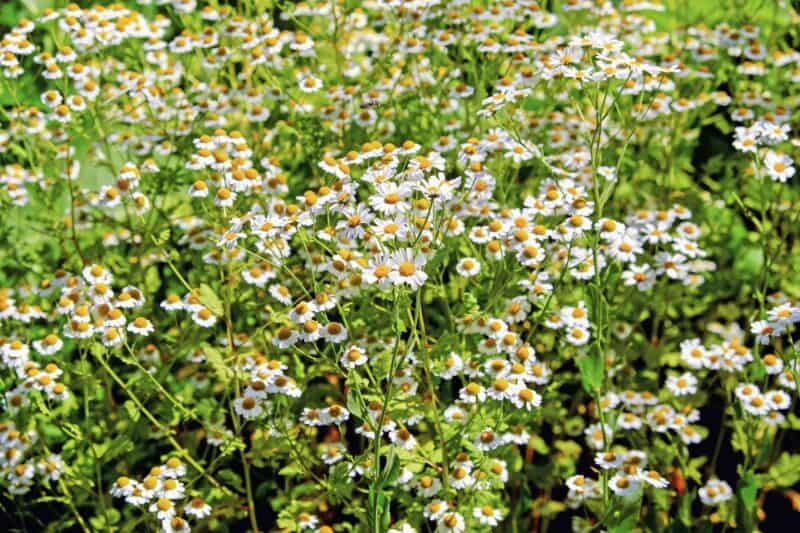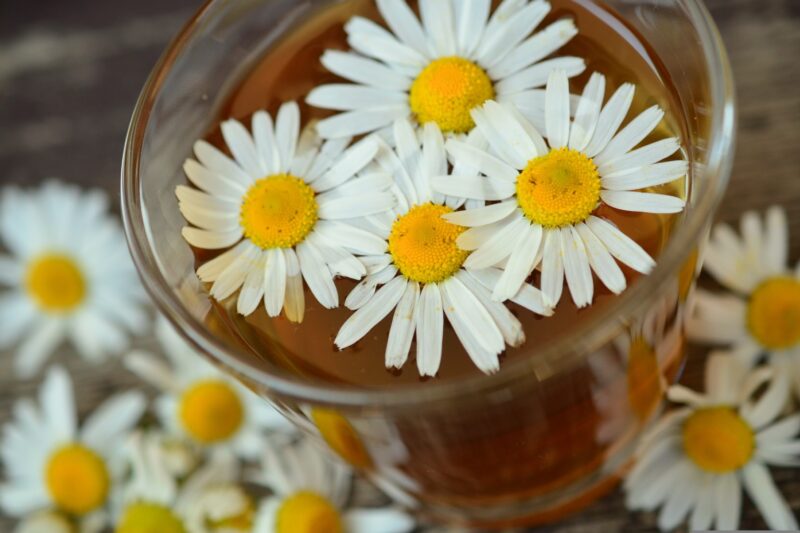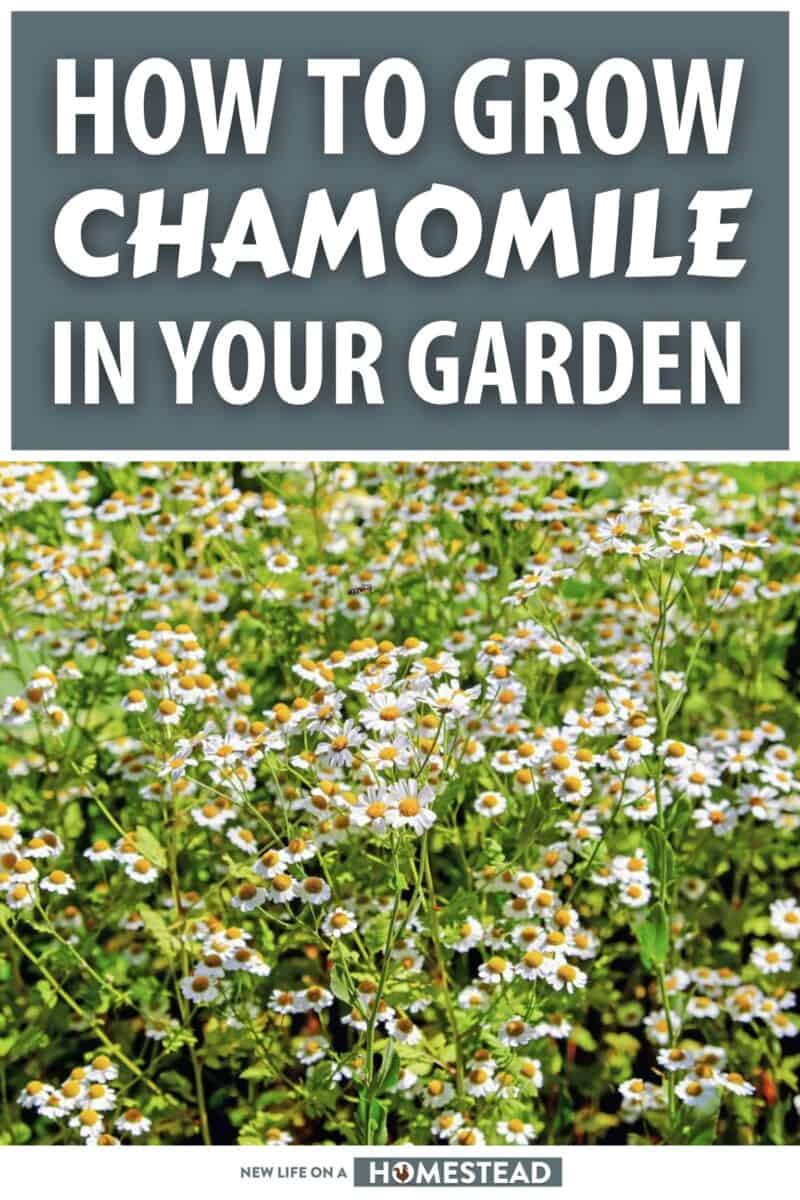Bright like daisies, and healthy for the body, Chamomile belongs to the Asteraceae family which is the name for several daisy-like plants.

This charmer blossom is grown mostly in Europe, Western Asia, and other countries with accommodating soil and they are considered to be a key ingredient in herbal teas.
Chamomile is popular in the United States as well, and it is quite easy to find many varieties and brands of chamomile tea on the shelves of any supermarket you visit.
Research has proven that it not only seeds in surplus, but it contains anti-anxiety, anti-inflammatory, and sedative property which is why it is recommended for those who have trouble sleeping.
This useful herb has have used for thousands of years all over the world to alleviate health issues and is being used as supplement to treat a variety of sicknesses and medical conditions in the modern day as well.
Chamomiles also add flavor to drinks and food, with their center plant containing apple flavor properties.
If you’re a homesteader, you should definitely consider adding useful, flavorful chamomile to your herb garden, or letting it grow a bit wild on the boundaries of your property.
Here is everything you need to know about the daisy beauty the Germans call “alles zutraut”, which aptly translates as “capable of everything”.
Table of Contents:
Chamomile Varieties
The Chamomile plant grows in two particular varieties in Europe, Egypt, and the western part of Asia.
The varieties all thrive in good soil and at a similar ph level. Locating these varieties to plant won’t be difficult.
You can find them in stores near you, in farmers’ markets, or order whichever variety you desire from seed and plant catalogs.
German Chamomiles: This variety of Chamomiles is easier to grow, tend to and cultivate. It is an annual variety that grows up to 3-feet tall and flourishes well in flower beds. Many believe that German chamomile is the variety that is most suited for herbal teas and medicinal purposes.
Roman Chamomile: This is a strong variety of Chamomile that grows perennially and can also be used as a cover crop due to its hardiness.
Roman chamomile’s strong apple fragrance makes it an easy pick for aesthetic purposes, and flavorings, and this plant still makes a great addition for flower pots and her container gardening.
The tea from this variety tastes nearly as good as the German one and they both offer the same herbal remedies.
Soil Type and PH
The most common varieties of Chamomile; German and Roman Chamomile, are best planted on fertile, drought-resistant soil.
The soil does not have to be too rich, but it must be well-drained and organically rich enough to supply the plant with all the essential nutrients.
The soil should not be overly moist as Chamomile plants are built to grow in drought-resistant areas. Excess water could tamper with their growth.
The soil ph ranges between 5.6-7.5 ph. This is to offer the plants the stability that will champion their growth.
Chamomile Hardiness
The hardiness level ranges between 2-9 USDA and the plants can be exposed to full sun. Balance in hardiness level advocates for a flourishing plant that can grow as tall as 5 feet.
How to Identify Chamomile and Different Chamomile Varieties
Most daisy-like plants look similar, and in an abundance of varieties, it is not always so easy to tell them apart.
Apart from common information that German Chamomiles are annual crops, and the Roman variety grows perennially, another easy way of telling them apart or recognizing them when you see them is their leaves.
German Chamomile has tiny leaves segmented beautifully into thin segments, while Roman leaves are slightly bigger, thicker, and segmented two times more than German chamomile.
When the flowers are dry, a split in the middle of at least five flowers can reveal which variety they belong to. The plant with a solid receptacle is Roman; the one with a hollow receptacle is German.
To recognize the plants when they are still fresh and flourishing, observe how the flowers are arranged on the plant. German Chamomiles arrange themselves in a comb-like pattern, and Roman Chamomiles sit in singles.
Another key way to identify the plant is by its scent. Roman varieties have a stronger scent, and German varieties have a milder scent not as thick as the former.
In a field, the degree of the scent can tell them two apart easily. The blossoms and the foliage also have differences that make identifying the plant easy.
The differences in each variety or between them and other plants in the same family are distinct. If you desire to purchase a particular variety, work closely with these tips.
Growing Chamomile in Your Garden
Chamomile seeds are best when they are started indoors and then transplanted once they’ve been hardened off and are ready for the garden. This should be done in the spring.
Direct sowing this herb can often be challenging, and it often fails to establish itself in the garden in this manner. However, if transplanted in the right conditions, Chamomile is often unstoppable!
Chamomile is best grown in full sun conditions, but it will tolerate partial sun as well.
The plant does not do well in consecutive hot dry weather, so southern and southwestern gardeners would best be served by opting for partial sun conditions when growing this herb. Chamomile is a great companion pan for other herbs, such as mint.
The robust, thick-growing nature of chamomile allows it to serve as a ground cover and will help prevent weeds and other plants from overtaking your herb garden and minimize the requirement for weeding.
As stated earlier, chamomile is a hardy plant, but you will have to watch your garden closely for powdery mildew and other pests.
However, this useful herb is often more resistant to these kinds of problems than many other herbs.
In fact, since chamomile is such a hardy grower, you may want to consider planting it on the boundaries and edges of your property, where you normally just let things get wild; if you do you may be able to harvest more than enough of this great herb from places that normally you’d just mow or neglect!
How to grow Chamomile in Containers
Chamomile also grows beautifully indoors, as well as when they are grown in gardens. However, they are to be tended closely so they don’t get too much or too little of any growth factor like water, and sunlight.
It is advisable to grow the perennial variety in containers, although both of them grow beautifully when planted.
To start, purchase nice large containers well perforated and drained. Purchasing large containers will save you the stress of transplanting the seedlings when they mature.
Ensure the soil type is compatible with the plants so they can flourish with ease. Sow about three seeds into a container and space them adequately.
The seeds must be sown in your container and exposed to sufficient sunlight so they can germinate.
When growing chamomile in containers, beware of the frosty autumn weather. Always bring them indoors to decrease the risk of exposing them to frost.
These plants bloom by themselves once the soil is right. You do not really need fertilizer to boost their growth.
Luckily, they are usually pest-resistant since they are not in open fields, but you must be mindful of pests that could still attack your herbs when you aren’t paying close enough attention.
Uses of Chamomile
Asides from the obvious use of chamomiles for herbal and medicinal purposes, they can be used for bouquets, decorations, flower pots, to make scents, and for aesthetics obviously.
Their beauty fits so well with calm scenery and in whatever atmosphere they are situated, they sure make it cool.
The plant is reputed to have many medicinal properties as well. For example, chamomile can be used to reduce blood sugar levels and treat diabetes. It is also said to offer relief from menstrual cramps.
Recent studies suggest it can be used to aid patients in the treatment of some forms of cancer as well, another example of how modern science is finding new and critical uses for this ancient herb.
Consuming Chamomile can aid with sleep, relaxation, and reducing tension, which is one of the reasons you find so much chamomile tea in your supermarket’s aisles.
It can be also be used to treat mild skin conditions, and just like the Echinacea, many people use chamomile to help address the symptoms so prevalent with the common cold. Finally, the herb has also been used to treat diarrhea in children as well.
How to Prepare Chamomile for use
Depending on what you need to use Chamomile for, the preparation differs. For the tea, to cure skin conditions, and other purposes, the preparation processes are slightly different, but relatively easy to do with the implements you already have in your kitchen.
The extract from the flower heads is used to make the tinctures used for mild skin conditions. The leaves are dried and used to brew tea.

Chamomile essential oil combined with lavender is used to heal sick illnesses. It is prepared by mixing the lavender extract with Chamomile oil which can be gotten in stores or extracted from the plant manually.
Teas, mouth rinse, tablets, liquid extract, and capsules can be gotten from the flowery top of the plant. The flowery top of the plant is separated from other parts of the plant, dried, and used for the designated purpose.
Chamomile Edibility and a Few Recipes
As discussed earlier, chamomile is mostly taken as a tea. The tea is made from dried flowers of the plant.
The plant can also be used to make beer which includes all the parts of the plant, not just the flowers. Ales can be made from chamomile too.
Generally speaking, every part of the plant can be used to create an edible recipe. A few of those recipes are listed below. To prepare Chamomile tea:
- Place a heaped teaspoon of dried Chamomile flower in a 2/3 cup of boiling water for five to ten minutes.
- Strain the mix with a standard tea strainer
- Watch for it to cool down and then you can proceed with consumption.
Here is a great video on preparing chamomile tea fresh from your garden:
To use the plant as a mouth rinse:
- Prepare the tea with the same steps as outlined above.
- Allow it to cool down to a temperature your mouth can tolerate.
- Then gargle as you desire.
Salad recipe
Chamomile flowers can be infused into almond oil and in turn used for salads, mixed with mayonnaise and side dishes.
Cereal Recipe
Fry the chamomile bright yellow center in hot butter till it’s slightly brown, and then mix it with your oatmeal or hot cereal to give it that nice apple flavor.
Chamomile Steamer
You can make a Chamomile steamer out of the plant. With a French press, warm milk, and a handful of buds, you can make a refreshing creamy latte to cool off after a long day. This recipe can be used to replace caffeinated lattes and it is very healthy.
Please note: Before using a plant to make an herbal supplement that will be consumed orally, ensure it has not been sprayed with insecticides because an insecticide-affected plant is not safe for oral use.
Quick facts on Chamomile
- The tea offers numerous health benefits some of which include relief from sore throats, inflammation, and osteoporosis.
- Chamomile tea can be made from dried or fresh Chamomile flowers.
- Flavonoids are a chemical component of Chamomile and it plays a pivotal role in making Chamomile a medicinal plant.
- Dosages in capsules, tablets, or liquid extracts must be measured accurately to avoid drastic side effects.
- Chamomile is more of a supplement than medication and it should not be used to replace medications.
- If a person is allergic to ragweed or some daisy plants in the Asteraceae family, they might also be allergic to Chamomile.
- Spacing the plant needs to be done right and on time, as fungus penetrates poorly spaced plants and exposes them to diseases. For single plants, an ideal spacing formula is a 30cm gap each way to reduce humidity.
- Chamomile is dangerous when mixed with aspirin or Non-steroidal anti-inflammatory drugs.
- The plant must not be used two weeks before or after surgery. The potency level is high and to avoid any interference with body organs, it is advisable to abstain from the plant or plant products before and after surgery.
- They can be produced into tablets, capsules, and liquid extracts.
Chamomile Pests and Diseases
Although drought resistant and adaptable to fair soil conditions, Chamomiles are still susceptible to pests and diseases.
There is no particular pest or disease that ferociously attacks the plant, but the result of any pest/disease issue is that the plant could die or wilt away.
The plant is attacked mostly by Aphids, powdery mildew, fungi, insects, and viruses. An example of fungi that the chamomile is susceptible to is Albugo tragopogonis (white rust).
Aphids are insects that eat the underparts of leaves. They are also carriers of plant diseases and so, could spread other diseases.
By the time the leaves of the plant are weakened, the plant begins to lack nutrients and it dies out.
Powdery mildew is a disease that weakens plants and gives them a white powdery appearance.
They wilt away from being moist and lacking sufficient sunlight for their growth. This is why it is advisable to water plants carefully and plant them in well-drained soil and containers.
If you detect affected plants, quickly remove them from the midst of others. Then space the plants, reduce the humidity, and water carefully so the plants are not too moist since the fungus responsible for powdery mildew thrives in very moist environments.
Snails and slugs do more of eating the leaves of your plant and sapping the nutrients. It is unable to flourish beyond a certain point and begins to look sickly.
What Does it Mean if Your Chamomile Leaves have White Dots?
If the leaf of a Chamomile plant has white dots, it has been attacked by Spider Mites. These mites remove the chlorophyll from plants and inject toxins that cause white dots to appear on the leaves of the plant.
You can exterminate these mites or control them with spray insecticides recommended for mites.
Parting Thoughts: A Great Addition to a Homesteader’s Herb Garden
You should definitely get some chamomile into your garden today. This great herb has found a home in gardens for thousands of years.
It is easy to grow and will complement the herbs you are already growing in your herb garden or on your patio in containers.
It is also a great plant that can be grown in places on your homestead that you would normally neglect altogether too.
Harvesting chamomile is easy, and it has so many medicinal and food uses that not growing it seems like an unforced error!
The herb will be invaluable in your kitchen and your herbal medicine cabinet and is something you can use to sell at farmer’s markets or trade with fellow homesteaders; so, head to your nearest local garden store or to your favorite online seed catalog and get started with this wonderful plant today!

When Tom Harkins is not busy doing emergency repairs to his 200 year-old New England home, he tries to send all of his time gardening, home brewing, foraging, and taking care of his ever-growing flock of chickens, turkey and geese.
